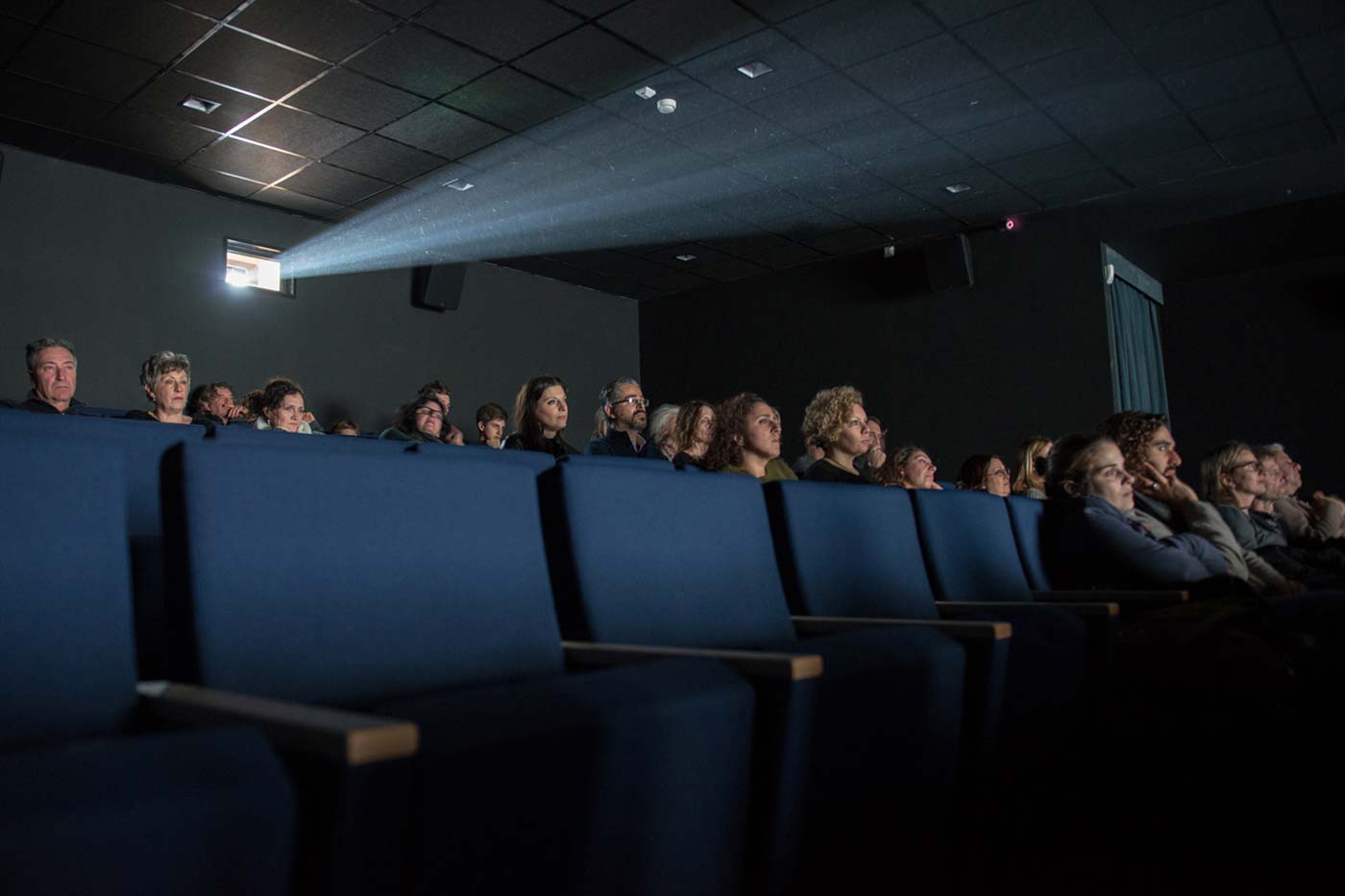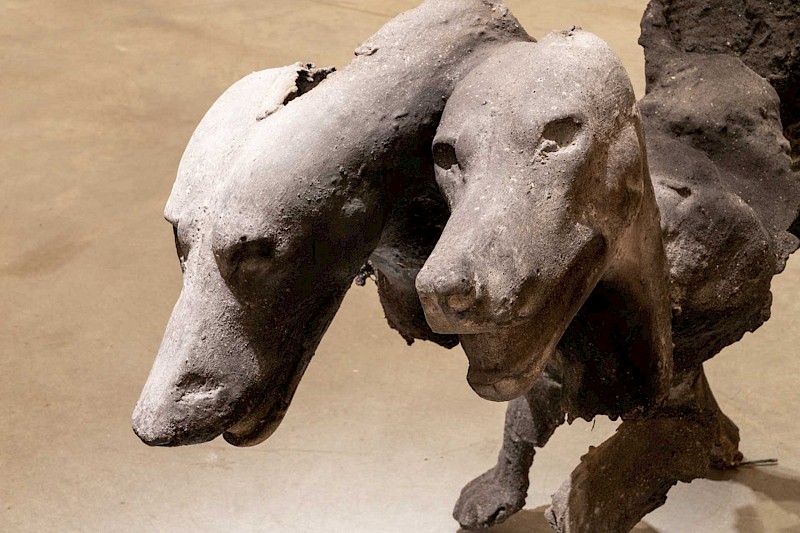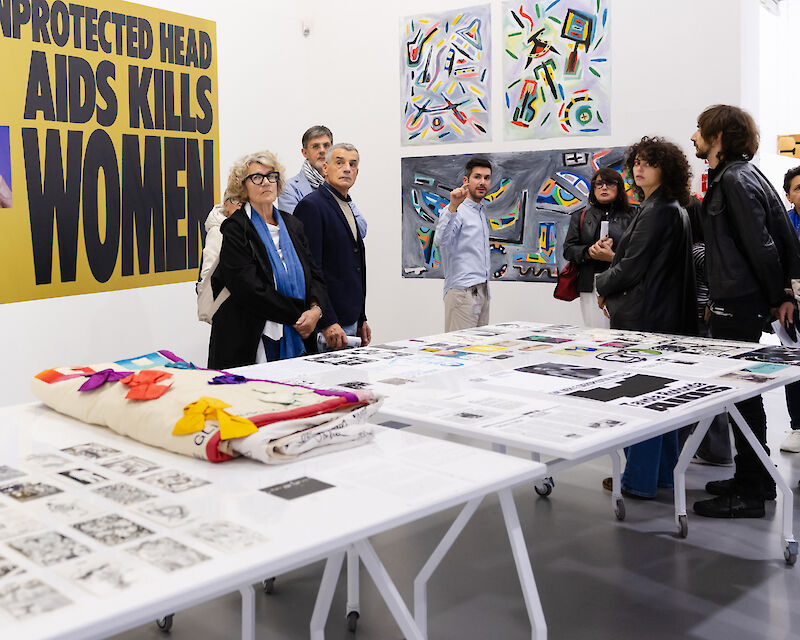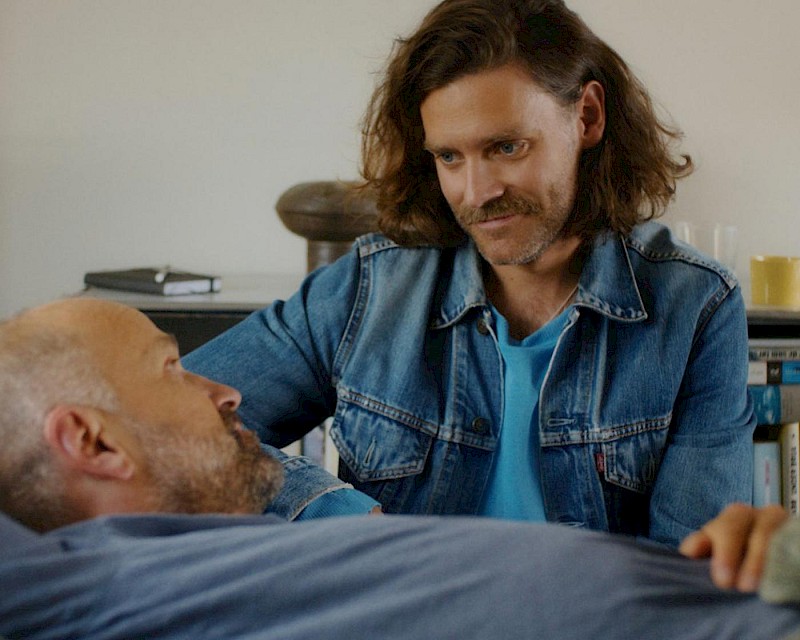VIVONO is the first institutional exhibition to reconstruct the forgotten history of Italian artists affected by the HIV-AIDS crisis. Works of art, poetry, soundscapes, and videos are interwoven with archival materials and personal memories to chart a possible path through the years 1982 to 1996—from the first reported case of AIDS in Italy to the arrival of antiretroviral therapies—conveying both the urgency and the uniqueness of that time.
The exhibition unfolds within the historic rooms of Centro Pecci, which, between 1992 and 1994, hosted numerous exhibitions, cultural events, and social initiatives to fight stigma and misinformation around AIDS. Today, in the museum’s permanent collection show, Eccentrica, it holds Commemuro (1993), an artwork created in memory of friends lost to AIDS, by Francesco Torrini. VIVONO acknowledges this genealogy and it is developed in collaboration with a committee of curators, archivists, and activists committed to revisiting the HIV-AIDS crisis through a contemporary lens.
The exhibition opens with a new film commission by Roberto Ortu, produced in close dialogue with curator Michele Bertolino. In the film, poems by Dario Bellezza, Massimiliano Chiamenti, Nino Gennaro, Ottavio Mai, La Nina, Marco Sanna, and Pier Vittorio Tondelli—poets who lived with HIV and gave voice to it in their writings—are read aloud by actresses, activists, and artists. Their words, at once spaces of confession in which the writers disclose the desire to be touched, come alive and plunge into the fabric of everyday contemporary life. It is a reflection on love and care that asks: how do we love together?
The archive is the backbone of the exhibition. Built collaboratively with Valeria Calvino, Daniele Calzavara, and I Conigli Bianchi, it gathers documents, posters, newspaper articles, videos, and sound fragments that, like notes, sketch out the historical, political, social, and cultural landscape of Italy between 1982 and 1996. To highlight the unfinished nature of this reconstruction, the materials are displayed on large mobile worktables, equipped with wheels, suggesting a narrative in constant motion and open to reconfiguration. Amid the historical documents, interventions by Emmanuel Yoro and Tomboys Don’t Cry offer contemporary perspectives, drawing attention to absences and silences. In relation to these materials, artworks by Italian artists—traces or testimonies, sometimes shouted at the top of their lungs, other times whispered—complicate our understanding of those years and invite deeper engagement with specific issues. They speak of lived experiences and convey an emotional atmosphere embracing both joy and sorrow, merging aesthetic research, political activism, personal stories, and philosophical thinking.
Works by international artists further these reflections. Featured are pieces that, when shown in Italy between 1982 and 1996, had a significant impact on the artistic community or activist movements: Gran Fury’s posters, exhibited at the 1990 Venice Biennale (and shown in Italy now for the first time since then), are placed in dialogue with works by Keith Haring; the blue sheer curtains by Félix Gonzalez-Torres (originally presented at Castello di Rivara in 1991) are shown alongside works by David Wojnarowicz and Walter Robinson, brought to Milan by Corrado Levi in 1984.
Three monographic rooms are dedicated to the work of Nino Gennaro, Francesco Torrini, and Patrizia Vicinelli—artists whose practices intertwine poetry, visuality, and the body inextricably. Each of these figures offers a distinct pathway through those years. Vicinelli lends physical weight to language, transforming it into flesh—fragile and defiant, capable of desiring and touching freedom. Nino Gennaro fights for housing rights and against the mafia; deeply embedded in an intersectional social fabric, his work speaks of affection and love, the importance of joy and mutual recognition, through a synthesis of verbo-visual research, theatre, and collages. Francesco Torrini, closely tied to the Florentine community of the 1980s and attuned to international experiences, evokes the body as a site of memory, distilling into his works a secular yet spiritual sensitivity. HIV-AIDS is not treated here as a subject or theme, but rather as a lens through which to perceive the world—its fragility, and a possible response in the form of beauty: tactile, relational, and alive—offered in the face of a pandemic too often met with silence.
The exhibition design, conceived by Giuseppe Ricupero, acts as a device for drawing visitors closer to the works. Developed in shades of white, it unfolds in daylight, among stories, people, and artistic positions that have long been kept in the shadows. Through mobile elements and structures tailored to each artist, the installation mediates between the institutional space of the museum and a more intimate, domestic dimension, emphasising the networks of affection, geographies, and bodies that traverse VIVONO.
How does one experience love and joy when everything around is darkness? What becomes of anger and hope when all seems lost? How do we breathe, how do we act together to build a future in a time of widespread threat and shared vulnerability? What alliances are forged in the search for the meaning of a smile? What words and images do we choose to speak of our losses—and our victories? How do we look each other in the eye?
VIVONO looks at the years of the HIV-AIDS crisis in Italy as a generative moment—one in which unexpected alliances were born, where love became a space for political action, translated into support, affection, care, and flesh. VIVONO is a collective story, a portrait of a living generation: written words, images, voices, and languages intertwine with sex, imagination, and mourning, evoking utopias that still belong to us, still resonate, still live.
The exhibition is accompanied by a two-volume catalogue, published by Axis Axis. The first, VIVONO. Archivio, is an extensive visual compendium where documents and artworks, arranged in a linear chronology, narrate the political and social history of those years and offer an entry point for deeper understanding. The second, VIVONO. Reader, gathers ten commissioned essays offering historical and art-critical perspectives alongside testimonies, as well as an anthology of poems and letters by several of the artists featured in the exhibition.
Curated by: Michele Bertolino
Researched by: Michele Bertolino, Isabella De Giorgis, Matteo Giampetruzzi, Giulia Zompa
Exhibition design: Giuseppe Ricupero con Rachele Calisti
Scientific Committee: Carlo Antonelli, Valeria Calvino, Daniele Calzavara, Stefano Collicelli Cagol, Conigli Bianchi (Tony Allotta, Luca Modesti “Er Baghetta”, Paola Vannutelli), Sara De Giovanni, Luca Locati Luciani, Ida Panicelli, Luca Scarlini
Team-Archive: Valeria Calvino, Daniele Calzavara, Conigli Bianchi (Tony Allotta, Luca Modesti “Er Baghetta”, Paola Vannutelli)
With works by: TOMBOYS DON’T CRY, Emmanuel Yoro
Director of Vivono: Roberto Ortu
Archives: Archivio Valeria Calvino; Archivio Pia Covre - Comitato dei Diritti Civili delle Prostitute; Archivio CSOA Forte Prenestino; Archivio Nicola Guiducci; Archivio Storico della Fondazione Carlo Donat-Cattin, Fondo Carlo Donat-Cattin; Archivio storico e Biblioteca Gruppo Abele; Centro di documentazione del Circolo “Maurice” GLBT; Centro di documentazione “F. Madaschi” - Cassero LGBTQIA+ Center; Centro di documentazione “Aldo Mieli”; Centro di documentazione Marco Sanna - Circolo di Cultura Omosessuale Mario Mieli; Centro di documentazione e informazione / Arti Visive - Centro Pecci; Centro Studi - Fondazione del Teatro Stabile di Torino; Fondazione FUORI!; Olivierotoscanistudio.
Press Office: PCM Studio - Paola Manfredi
International Press Office: Sam Talbot
Artists: Mario Appignani (con Andrea Falcon), Asdrubale, Lanfranco Baldi, Luciano Bartolini, Dario Bellezza, Gea Casolaro, Roberto Caspani, Massimiliano Chiamenti, Luis Frangella, Nino Gennaro, John Giorno, Nan Goldin, Felix Gonzalez-Torres, GOTSCHO, Gran Fury, Hervé Guibert, Keith Haring, Derek Jarman, La Nina, Zoe Leonard, Leonilson, Corrado Levi, Lovett/Codagnone, Ottavio Mai, Robert Mapplethorpe, Porpora Marcasciano, Kristin Oppenheim, Walter Robinson, Marco Sanna, Vittorio Scarpati, Andres Serrano, Giovanni Testori, Pier Vittorio Tondelli, Francesco Torrini, Maurizio Vetrugno, Patrizia Vicinelli, David Wojnarowicz, Bruno Zanichelli
With video works by: Elisabetta Fabrizi, Chiara Fatti & Costanza Salvi, Valerio Governi, Nicola Guiducci, Miguel Malafronte, Clelia Sedda, Emanuela Grimalda & Michael Ennemoser, Larry Pattume & Tony Ratto, Monica Petracci & Sauro Rossi, Stefano Ragazzi
Transports and Logistics: Chiara Olivieri Bertola
Condition report: Rachel Morellet






